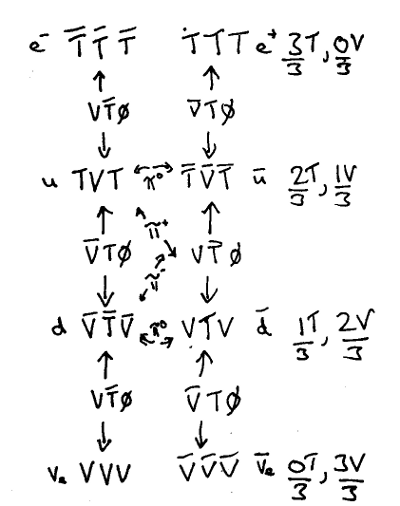Next: Example particle decay (phase Up: Quarks and other Elementary Previous: Patterns in Magnetic Moment Contents
As this is the Rishon level it should come as no surprise that there are patterns to particle decay which go down to the level of Rishons. There is nothing inconsistent with Standard Models: it's just different yet also conserves Rishon charge and phase, as well as continuing to respect Standard Model rules - just in terms of Rishon Model rules.
Analysis of several decay patterns shows that it is possible for the base triplet Rishons (of which there are 8 if the anti-particles are included) to phase-shift in two distinct groups. Also, it has been noted that two opposing phase-shifts must occur at the same time, where one phase-shift is the direct opposite of the other. This makes sense as far as conservation of energy is concerned. The two groups are as follows:
In other words: in each group, the difference between the left-hand side of the equation and the right is one particle-anti-particle pair of T and V. Two such exchanges (one from each group) must occur together.
Put as a law:
A pair of Rishon triplets may interchange one particle of one type of matter (T with its anti-particle or V with its anti-particle) whilst also simultaneously interchanging the other type's anti-particle (anti-V with V or anti-T with T)
Whether this is what is actually occurring at the physical level is almost
irrelevant: the mathematical differences are what counts. However what is
believed to be the case is that V
![]() 0 and
0 and
![]() T0 represent phase shifts rather than
being actual "particles". The exact allowed time difference allowed in between
when these phase shifts are permitted to occur is yet to be determined, if
there is in fact any time difference permitted at all: it is anticipated that
the time is zero, otherwise energy is not properly conserved.
T0 represent phase shifts rather than
being actual "particles". The exact allowed time difference allowed in between
when these phase shifts are permitted to occur is yet to be determined, if
there is in fact any time difference permitted at all: it is anticipated that
the time is zero, otherwise energy is not properly conserved.
As an example: a neutrino and a down-quark (from the first group) may be permitted to phase-shift to an electron and an up quark (again, first group) as long as simultaneously a second-group pair also phase-shifts, for example an anti-up quark and an anti-electron phase-shift to an up quark and a down quark:
Examine those two equations above carefully. In both cases, subtracting the
left-hand (or right-hand) two triplets from each other leaves the total number of Rishons as being the centre i.e.
![]() T0 in the first equation
and V
T0 in the first equation
and V
![]() 0 in the second. Making that clearer:
0 in the second. Making that clearer:
Where the Rishon triplets come from (compound particles, gluons) is irrelevant (i.e. which four triplets are involved): the phase shifts result in what is known in the Standard Models as "particle decay". The only other rule is also in the Standard Models: Rishon triplet and anti-triplet pairs may either be brought into existence for very short durations of time (the process is tentatively named "gluons"), or they may annihilate to create gamma radiation, or, if sufficient energy is input a triplet-anti-triplet virtual pair (typically Pions) may be separated such that, in combination with paired phase-changes interacting with surrounding matter, other larger particles may be created.
It's worth noting that the VT0 phase changes are likely to be made clear in Clifford Algebra, as described in Piotr Zenczykowski's paper on <a href="http://arxiv.org/abs/0803.0223">O(6) phase space</a>. It is suspected that the phase changes would be a simple pair of matching matrix transformations.
In diagrammatic form, here are the transformations that can take place:
 figureChart showing the chain of permitted transformations
figureChart showing the chain of permitted transformations
|
Bear in mind that the transformations may only take place in matched pairs. Note that the electron and neutrino (and their anti-particles can only each undergo a phase shift to one other particle! Also shown on the chart (which becomes useful later) are the Pions. The Pions are the only particles which may be involved in back-to-back phase transformations (thanks to their constituent parts having two possible paths each). The Standard Model calls these back-to-back phase shifts "gluons" and "W-Bosons".